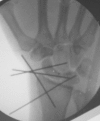Perilunate injuries
- PMID: 22379432
- PMCID: PMC3041883
- DOI: 10.1007/s11552-010-9293-5
Perilunate injuries
Abstract
Perilunate dislocations and fracture dislocations are most often a result of high-energy trauma, exerting an axial load with hyperextension and ulnar deviation of the wrist, along with intercarpal supination. Early treatment of perilunate injuries is necessary to optimize the clinical outcome. Although closed management has been the more commonly reported treatment for perilunate injuries, the current consensus is that anatomic restoration of carpal alignment has better results. The combined dorsal-volar approach offers the advantages of both approaches and is the preferred choice for the authors since it allows assessment of all the injured structures. The surgical techniques to restore carpal alignment and repair the scapholunate interosseous ligament are discussed. Current literature regarding treatment and prognosis is also included.
Keywords: Dislocation; Fracture; Perilunate; Treatment; Wrist.
Figures







References
-
- Adkison JW, Chapman MW. Treatment of acute lunate and perilunate dislocations. Clin Orthop Relat Res. 1982;164:199–207. - PubMed
-
- Apergis E, Maris J, Theodoratos G, Pavlakis D, Antoniou N. Perilunate dislocations and fracture-dislocations. Closed and early open reduction compared in 28 cases. Acta Orthop Scand Suppl. 1997;275:55–9. - PubMed
-
- Berger RA. A method of defining palpable landmarks for the ligament-splitting dorsal wrist capsulotomy. J Hand Surg. 2007;32A:1291–5. - PubMed
-
- Campbell RD, Jr, Thompson TC, Lance EM, Adler JB. Indications for open reduction of lunate and perilunate dislocations of the carpal bones. J Bone Joint Surg Am. 1965;47:915–37. - PubMed
LinkOut - more resources
Full Text Sources

